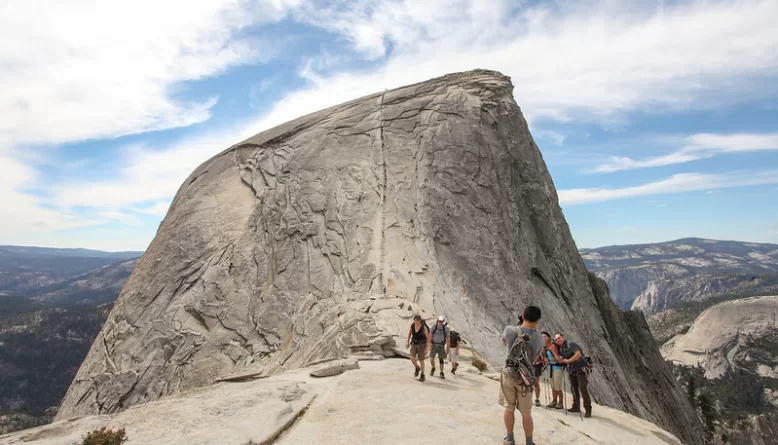Yosemite National Park is a dream destination for many outdoor enthusiasts. Hiking Half Dome is one of the most iconic experiences that the park has to offer. The hike is challenging, but the views from the top are breathtaking. In this ultimate guide, we will provide you with all the information you need to hike Half Dome in Yosemite National Park.
Introduction
Half Dome is a granite dome that rises 4,737 feet above Yosemite Valley. The hike to the top of Half Dome is a challenging 14 to 16 miles round trip with an elevation gain of 4,800 feet. The hike is not for the faint of heart, but the stunning views from the summit make it all worthwhile.
Preparing for the Hike
Permits
Permits are required to hike Half Dome, and they are in high demand. There are two ways to obtain a permit: through the lottery system or as part of a wilderness permit. The lottery system opens in March and closes in April, and the results are announced in May. If you do not get a permit through the lottery system, you can try to obtain one as part of a wilderness permit.
Training
Hiking Half Dome is a strenuous activity, and it is essential to train beforehand. You should engage in cardiovascular exercises and strength training to build your endurance and strength. It is also recommended to do some practice hikes to get used to hiking with a backpack.
Gear
Proper gear is essential for a successful hike. You should wear sturdy hiking shoes or boots, breathable clothing, and a hat to protect yourself from the sun. You should also bring a backpack with plenty of water, snacks, and extra layers. A hiking pole can also be useful, especially on the descent.
Weather
The weather in Yosemite can be unpredictable, so it is essential to check the forecast before your hike. Thunderstorms can occur in the afternoon during the summer months, so it is recommended to start early and finish the hike before noon. It is also essential to bring rain gear in case of unexpected weather changes.
The Hike
The hike to Half Dome can be broken down into three parts: the Mist Trail, the John Muir Trail, and the Cable Route.
The Mist Trail
The Mist Trail is a 3-mile trail that starts at the Happy Isles trailhead. The trail follows the Merced River and takes you to the base of Vernal Fall. From there, the trail becomes steeper, and you will climb up the granite steps next to the waterfall. The mist from the waterfall can make the trail slippery, so it is essential to wear proper footwear.
The John Muir Trail
After reaching the top of Vernal Fall, you will continue on the John Muir Trail for another 2.7 miles to reach Nevada Fall. The John Muir Trail is less steep than the Mist Trail and offers stunning views of the surrounding mountains.
The Cable Route
After reaching the top of Nevada Falls, you will continue on the John Muir Trail for another 1.5 miles to reach the base of Half Dome. The Cable Route is a steep and exposed climb that requires the use of cables to ascend to the summit. It is essential to be physically and mentally prepared for this part of the hike.
Summiting Half Dome
The Cable Route is the most challenging part of the hike, but also the most exhilarating. The cables are steel ropes that are anchored to the rock and run up the final 400 feet to the summit. Hikers wear gloves and use the cables to pull themselves up the steep slope. The ascent can be physically and mentally demanding, and it is essential to take breaks when needed.
At the top of the cables, you will reach the Subdome, a large granite dome that offers stunning views of Yosemite Valley. From the Subdome, you will continue on a narrow path to reach the summit of Half Dome. The summit offers 360-degree views of the surrounding mountains, including Yosemite Valley, Glacier Point, and Yosemite Falls.
Safety Tips
Hiking Half Dome can be dangerous if proper precautions are not taken. Here are some safety tips to keep in mind:
- Always check the weather forecast before your hike and bring appropriate gear.
- Start early in the morning and finish the hike before noon to avoid thunderstorms.
- Take breaks and drink plenty of water to avoid dehydration.
- Use the cables and stay on the designated path to avoid accidents.
- Be aware of your surroundings and watch out for wildlife.
Conclusion
Hiking Half Dome is a challenging but rewarding experience that offers stunning views of Yosemite National Park. It is essential to prepare properly for the hike, including obtaining a permit, training, and bringing appropriate gear. The hike can be broken down into three parts: the Mist Trail, the John Muir Trail, and the Cable Route. Summiting Half Dome requires physical and mental preparation, but the views from the top make it all worthwhile. Remember to take proper safety precautions and enjoy the journey!
Related Article: 5 Breathtaking Yosemite Waterfall Hikes You Can’t-Miss
FAQs
How long does it take to hike Half Dome?
The hike is 14 to 16 miles round trip and can take 10 to 14 hours to complete.
Do I need a permit to hike Half Dome?
Yes, permits are required and can be obtained through the lottery system or as part of a wilderness permit.
Is hiking Half Dome dangerous?
Hiking Half Dome can be dangerous if proper precautions are not taken. It is essential to be physically and mentally prepared and to follow safety guidelines.
What is the best time of year to hike Half Dome?
The best time to hike Half Dome is from late May to early October when the cables are up and the weather is mild.
Are there any age restrictions for hiking Half Dome?
There are no age restrictions, but it is essential to be physically and mentally prepared for the hike. Children under the age of 12 are not recommended to hike the Cable Route.
Related Article: The Ultimate Guide to Hiking the Yosemite High Sierra Camps Loop



No Responses Yet